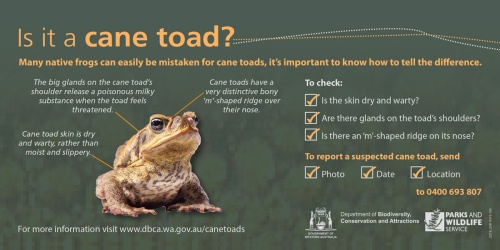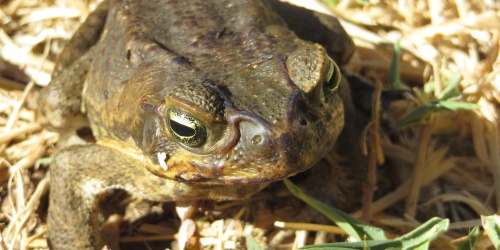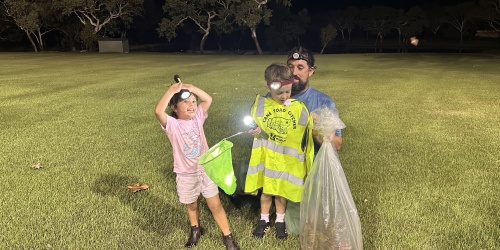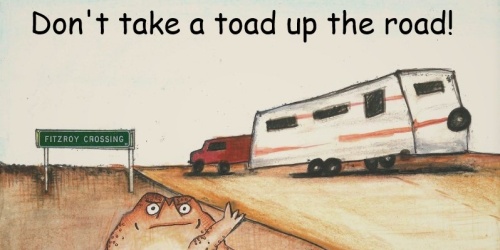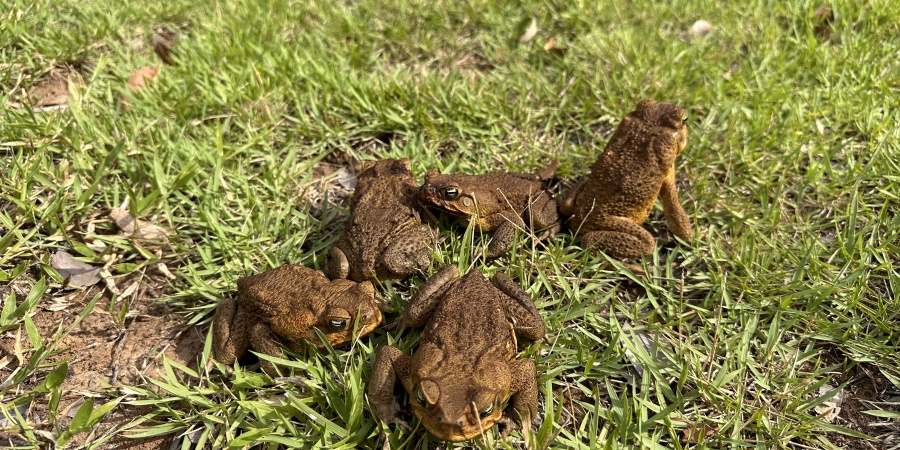
Scientific name: Rhinella marina | Family: BUFONIDAE
Status: Declared pest North of the 26th Parallel in WA under the Biosecurity and Agriculture Management Act 2007
The impact of cane toads on Western Australia’s biodiversity
The arrival of cane toads has led to population declines of various species, including the endangered northern quoll (Dasyurus hallucatus), floodplain goanna (Veranus panoptes) and freshwater crocodile (Crocodylus johnstoni).
The invasion of cane toads is a key threatening process for the northern quoll, leading to its endangered status, as recorded under the EPBC Act. These population declines in toad sensitive species have been attributed primarily to lethal toxic ingestion, resulting from the animals mouthing or attempting to eat cane toads.
Cane toads will also compete with various animals in the ecosystem for the same food sources and will predate on anything small enough to fit in their mouth causing predation pressure.
Managing Western Australia's cane toad problem
Since 1986, the Australian Government, numerous State Governments and universities have invested time and funding into research to develop tools to control cane toads across Australia at a landscape scale, but so far without success.
Recognising this, DBCA's primary objective in cane toad management is to mitigate the impact of cane toads and where possible minimise the immediate risk of species decline as cane toads spread through Western Australia.
One approach undertaken by a group of research, conservation and land management organisations across Australia is in conditioning native species to avoid eating cane toads. Visit the Mitigating the impacts of cane toad on WA native animals page for more information.
Managing cane toads across the vast, remote, and sometimes inaccessible terrain of Western Australia, crossing multiple jurisdictional boundaries, presents significant challenges. However, one approach involves creating localised "enclaves" where native predator populations can persist. Using toad control and/or conditioned taste aversion in native species, may allow the survival and persistence of native predator populations. From these enclaves, the native predators can disperse and recolonise adjacent regions where the toad invasion significantly impacts the region's species.
Where are cane toads currently found in WA?
The cane toad front advances at about 50km per year on average. The invading pioneers are generally large, long-legged, mostly male cane toads that invade new ground. Breeding toads follow six or twelve months after, and tadpoles and metamorph toads may be observed at this point.
What DBCA does to manage cane toads
Monitoring and surveillance
DBCA, researchers and land managers annually join forces during the wet season to track the distribution of cane toads. This involves employing various monitoring techniques, including nocturnal observations to visually spot and listen for the toads, as well as collecting water samples for DNA testing to identify the presence of cane toads. Surveillance and monitoring helps identify locations of cane toads 50km ahead of the cane toad front line and to track population growth over time.
Toad control ahead of the frontline
Toad musters involve the capture and humane killing of cane toads, which can eradicate satellite populations that are more than 50 kilometres ahead of the frontline.
Toad musters may also be used to control toad numbers at ecologically important sites such as small wetlands and gorges.
For information on getting involved with toad musters in the community, visit: Cane Toad Community Involvement
Conditioned Taste Aversion: Mitigating the impacts of cane toads on native animals.
Considering the emphasis on actively mitigating the risk of native species decline, conditioned taste aversion (CTA) is one approach currently demonstrating positive outcomes in teaching native predators to avoid consuming cane toads. CTA involves offering a cane toad bait laced with a nausea inducing agent to species susceptible to cane toads. The chemical causes them to become ill and subsequently associate the scent and taste of the cane toad with sickness. This deters them from consuming cane toads when they arrive in uninvaded areas. Visit the departments Mitigating the impacts of cane toads on native animals web page for more information.
Partnerships
Coordinating the collective efforts of traditional owners, universities, local authorities, natural resource management groups, industry, landowners, and the broader community, brings together a network of resources and expertise to provide WA’s native species with the best chance of survival against cane toads.
Strategies and legislation that underpins cane toad management
Legislation underpinning cane toad management decisions
Cane toad management operates within several legal frameworks and strategies at both national and state levels, which aim to protect and manage threatened fauna of state and national significance. Links to legislation underpinning cane toad management can be found on the Invasive animal management page. The following strategies and policies relate directly to the management of cane toads.
